Buda
Buda (Hungarian pronunciation: [ˈbudɒ]; German: Ofen, Croatian: Budim, Serbian: Будим, Czech and Slovak: Budín, Turkish: Budin) was the ancient capital of the Kingdom of Hungary and since 1873 has been the western part of the Hungarian capital Budapest, on the west bank of the Danube. Buda comprises a third of Budapest's total territory and is in fact mostly wooded. Landmarks include Buda Castle, the Citadella, and the president of Hungary's residence, Sándor Palace.

Demographics
.svg.png.webp)

The Buda fortress and palace were built by King Béla IV of Hungary in 1247, and were the nucleus around which the town of Buda was built, which soon gained great importance, and became in 1361 the capital of Hungary.[2]
While Pest was mostly Hungarian in the 15th century, Buda had a German majority;[3] however according to the Hungarian Royal Treasury, it had a Hungarian majority with a sizeable German minority in 1495.[4] Buda became part of Ottoman-ruled central Hungary from 1541 to 1686. It was the capital of the province of Budin during the Ottoman era. By the middle of the seventeenth century Buda had become majority Muslim, largely resulting from an influx of Balkan Muslims.[5]
In 1686, two years after the unsuccessful siege of Buda, a renewed European campaign was started to enter Buda, which was formerly the capital of medieval Hungary. This time, the Holy League's army was twice as large, containing over 74,000 men, including German, Dutch, Hungarian, English, Spanish, Czech, French, Croat, Burgundian, Danish and Swedish soldiers, along with other Europeans as volunteers, artillerymen, and officers, the Christian forces reconquered Buda (see Siege of Buda).
After the reconquest of Buda, bourgeoisie from different parts of southern Germany moved into the almost deserted city. Germans — also clinging to their language — partly crowded out, partly assimilated the Hungarians and Serbians they had found here.[3] As the rural population moved into Buda, in the 19th century slowly Hungarians became the majority there.
Notable residents
- Edmund Hauler (1859-1941), classicist and philologist
- Andrew III of Hungary, buried in the Greyfriars' Church in Buda
- Jadwiga of Poland, born here, first woman proclaimed to be 'king' of Poland
- Kornelije Stanković, notable Serbian composer, born and died in Buda
- Ignaz Philipp Semmelweis (1818-1865), a Hungarian physician and scientist. An early pioneer of antiseptic procedures, he proposed doctors start the practice of washing hands
Twin cities
 Capestrano, Italy
Capestrano, Italy
Gallery

 Országház utca (= Parliament Street)
Országház utca (= Parliament Street) Buda Main Plaza
Buda Main Plaza Arany Hordó Inn
Arany Hordó Inn Old Parliament Inn
Old Parliament Inn Tárnok utca (= Treasury Street)
Tárnok utca (= Treasury Street)
See also
References
- Nyerges, András, ed. (1998). Pest-Buda, Budapest szimbólumai [Budapest arms & colours: throughout the centuries]. Budapest: Budapest Főváros Levéltára. p. 2.
- The Budapest article of Encyclopædia Britannica 1911
- "Budapest". A Pallas Nagy Lexikona (in Hungarian). Retrieved 2009-11-03.
- Károly Kocsis (DSc, University of Miskolc) – Zsolt Bottlik (PhD, Budapest University) – Patrik Tátrai: Etnikai térfolyamatok a Kárpát-medence határon túli régióiban, Magyar Tudományos Akadémia (Hungarian Academy of Sciences) – Földrajtudományi Kutatóintézet (Academy of Geographical Studies); Budapest; 2006.; ISBN 963-9545-10-4, CD Atlas
- Faroqhi, Suraiya (1994). "Crisis and Change, 1590-1699". In İnalcık, Halil; Donald Quataert (eds.). An Economic and Social History of the Ottoman Empire, 1300-1914. 2. Cambridge University Press. p. 440. ISBN 0-521-57456-0.
Further reading
- Richard Brookes (1786), "Buda", The General Gazetteer (6th ed.), London: J.F.C. Rivington
- David Brewster, ed. (1830). "Buda". Edinburgh Encyclopædia. Edinburgh: William Blackwood.
- John Thomson (1845), "Buda", New Universal Gazetteer and Geographical Dictionary, London: H.G. Bohn
- Charles Knight, ed. (1866). "Buda". Geography. English Cyclopaedia. 2. London: Bradbury, Evans, & Co.
External links
| Wikivoyage has a travel guide for Budapest/Buda. |
